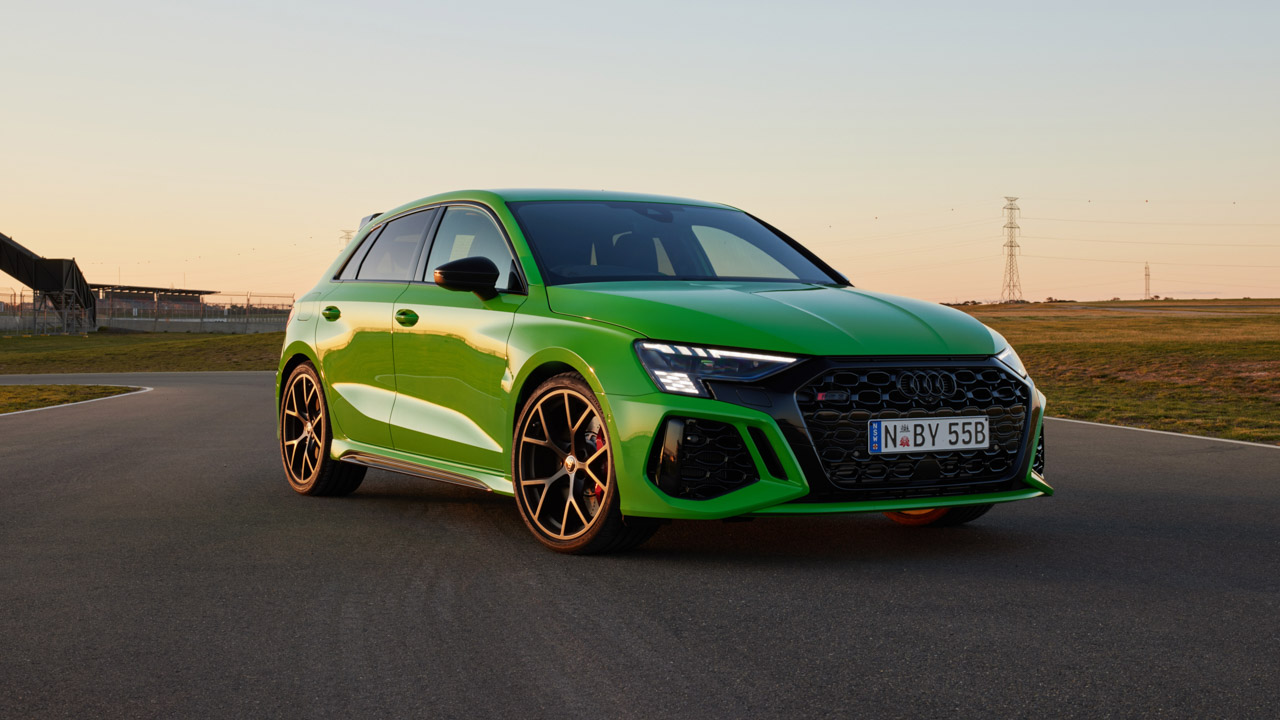Audi’s characterful five-cylinder is mated to a more agile chassis than ever before, and the while the rear diff’s drift mode may seem gimmicky it’s a hoot in real life
- Clever rear diff allows power oversteer
- Well-judged ride
- Extremely characterful engine
- Everyday usability
- Dearer to buy than before
- Light on steering feel
- Tire roar on coarse chip surfaces
- Not as focused as some rivals
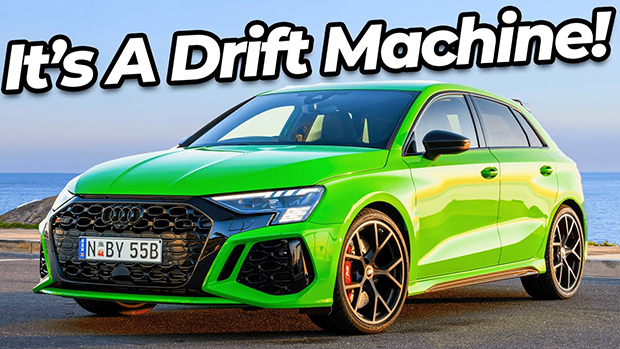
Audi’s RS3 is still young, at only three generations old globally and sold in Australia in sporadic bursts in second-gen form since 2018. Yet in that time its five-cylinder warble and AWD traction have put this hyper hatch on the map.
It appears quite value laden, too. Despite a 10 percent price rise, at $91,391 before on-road costs the new Sportback version undercuts rivals such as the similarly rapid Mercedes-AMG A45 S ($99,895 before on-road costs), while outgunning the $100K-plus BMW M2 in a straight-line sprint.
This new version also aims to fix old shortcomings. As quick as the last car was, there were criticisms: it didn’t have the effortless adjustability of a BMW and felt lead-tipped next to AMG’s ultra-sharp A45.
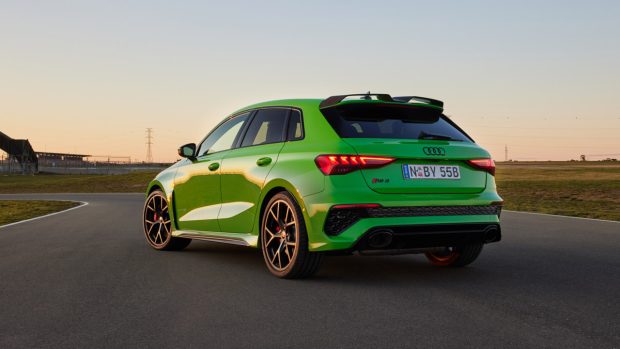
One of the other niggles where the RS3’s looks. The old car was so subtle as to be almost apologetic. The new car’s been in for a makeover with pumped front arches, functional air vents, gorgeous five Y-spoke 19-inch alloy wheels and blacked-out front for a mean stance to match the seductive five-pot soundtrack. The treatment is especially punchy when finished in a bold shade of ‘Kyalami green‘or’python yellow‘.
The new car retains the 294kW alloy-block 2.5-liter turbo petrol five-cylinder while adding an extra 20Nm, for a total of 500Nm, for good measure and focuses on making a more driver-friendly experience by eradicating understeer.
Audi RS engineers have also addressed the old version’s front-end push with a 33mm-wider front track, fitting ‘reverse-staggered’ tires (265/30 front, 245/35 rear) as standard. The RS3’s electronically controlled twin-clutch limited-slip rear differential, facilitating a new drift mode, is also fantastic, but it’s the whole suite of subtle changes that have truly elevated the RS3 above its predecessor.
How does the RS3 drive?
Surely drift modes are gimmicks. When on earth are you really going to turn off ESC, engage the RS3’s ‘Rear Torque‘setting and slide it around? It’s certainly not advisable in public. But, with a wet skid pan at our disposal at the new version’s local launch, it would’ve been rude not to have a crack.
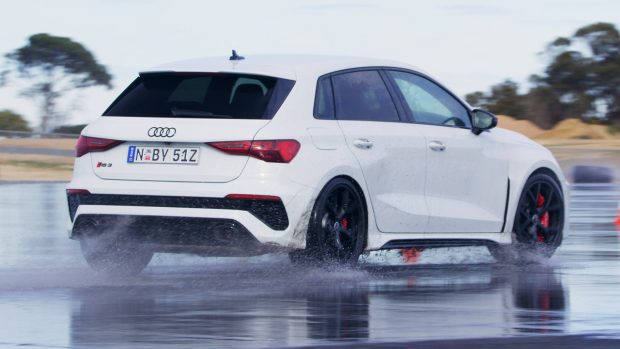
The new diff doesn’t eliminate understeer completely – ham-fisted driving still had our white Sportback’s front 265/30 R19 Bridgestone S007s grumbling and sliding – but you can initiate a balletic drift with a boot full of throttle. It’s not precision driving, but when the RS3 is dancing around traffic cones it’s hard to suppress full-blown belly laughs.
The skid pan was also my first experience of the RS3. Going straight to bouncing off the rev-limiter in second (it holds gears in manual mode) revealed that, despite having a petrol particulate filter (PPF), the new RS3’s active exhaust is louder than the system it replaces, one that was fitted with sound-strangling emissions equipment toward the end of its life.
To this point, the RS3’s theatrics had me seriously impressed.
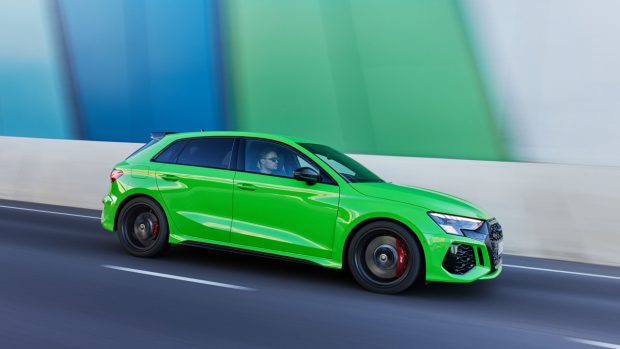
Next up was a brief stint at the Bend Raceway’s 3.41km West circuit, perhaps where the RS3 felt least at home. It was still fun with more on-power adjustability than expected and a deft ESC tune that allows generous dynamic driver engagement. However, the Sportback struggled with high-speed direction changes; a 1570kg weight figure, tall stance and suspension that’s supple and absorbent on road make it not a natural track tool.
All RS3s have 375mm cross-drilled and ventilated rotors clamped by six-piston front calipers, but the on-track cars were equipped with the eye-watering $13,000 carbon-ceramic stoppers (twinned with a heightened 290km/h speed limiter). The pedal felt firm and responsive in the three-lap sessions.
Away from ripple strips and ultra-smooth tarmac the RS3’s slight body roll translated to a friendly and exploitable car on the road. With the suspension set to middling ‘Balanced’ mode it dealt with bumps beautifully. Amping the RS3 in Dynamic mode adds more aural drama, steering weight and noticeably tighter body control that didn’t hugely impact ride comfort.
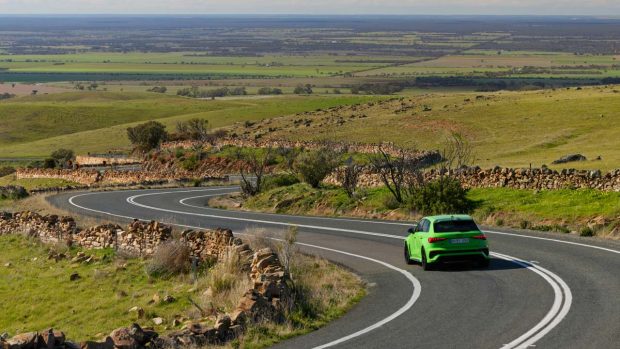
The RS3 is enormously quick in the real world, with engineer’s able to cut three tenths from the claimed 0-100km/h time – now 3.8 seconds – with no extra power. The new car has the same 294kW power output as the old version, but now spread between 5600-7000rpm. The torque increase is also not to be sniffed at, with the peak 500Nm figure (up 20Nm) on tap from 2250-5500rpm. The result is a car that does indeed feel a lot more special than its $69,900 four-cylinder S3 sibling.
Adding to the RS3’s sense of occasion is, again, that quattro system’s rear differential. It’s fun in a controlled environment, but also helps enormously on the road. Once past the slight off-center vagueness of the RS3’s quick steering rack, there’s now on-power adjustability available. It isn’t as tail-happy as BMW’s longitudinal, rear-biased xDrive system in the M240i, but it is sharp, precise, and addictive.
The hum of the performance-oriented Bridgestone tires on coarse chip freeways broke the serenity of the otherwise refined RS3. Dipping out of the Adelaide Hill’s incredibly tight and technical roads back into the doldrums of city life the RS3 still felt at home, its ride is far from uncompromising, and below 60km/h the RS3 Audi feels no more brittle in ride quality than a 35 TFSI Sportback.
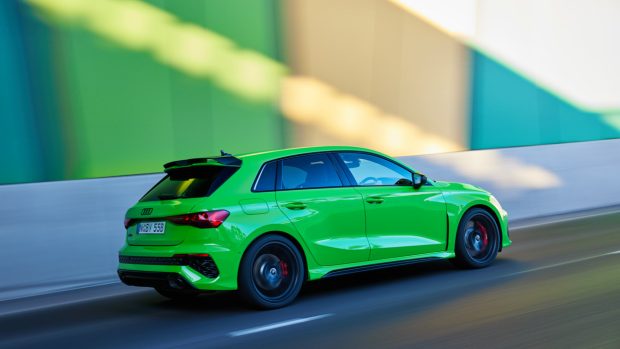
Audi’s safety suite features well-tuned adaptive cruise control and lane-keep assist programs fitted as standard to the RS3. Our car had blind-spot monitoring, but lacked a 360-degree camera due to semiconductor shortages, which dropped the list price by $975. Other safety features include front AEB with pedestrian, cyclist and junction detection, as well as rear AEB, a crisp reversing camera, front and rear parking sensors and auto-parking.
How is the RS3’s inside?
Inside is where Audi’s switchgear really trounces the closely-related Volkswagen Golf R, but the same can be said of the $20K cheaper S3. It could be argued that the RS3’s cabin lacks visual drama over its four-pot sibling, but the tech integration and build quality is still seriously impressive.
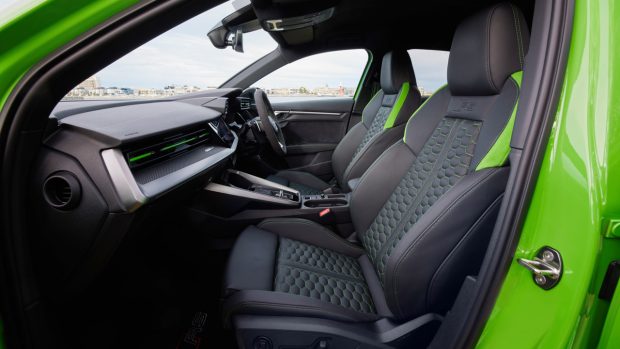
Customers can also make the RS3 ‘theirs’ with a $7400 (or $6200 for the sedan) carbon pack with carbon-fibre cabin trim, mirror caps, a rude rear wing and black exterior bading. The RS Design pack ($2150) is also available with an Alcantara-appointed steering wheel and contrasting interior accents in either lime green or red to add visual interest.
Unlike the related Volkswagen Golf R, the RS3’s 10.1-inch touchscreen has tactile haptic feedback, is crisp to look at and is backed up by a strong processor. There is no faffing around missing targets as they’re big enough not to need reading glasses.
Below the touchscreen sit physical controls for the HVAC and seat heating and the onboard navigation’s live traffic system is one of the best out there. Of course, there’s wireless Apple CarPlay and Android Auto if you prefer Waze or Google Maps, but Audi’s cartographic satellite maps displayed in the 12.3-inch digital driver’s display were my preference.
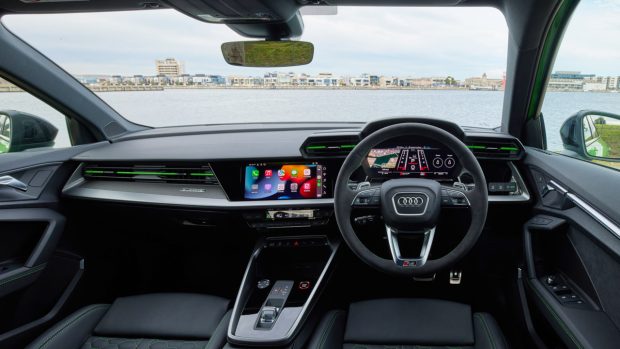
A wireless charging pad is included as standard in all RS3s and there are two USB-C fast-charging ports for juicing up other devices in the cabin. The door bins are flocked and the general material quality is high.
The cool air vent design, high-quality plastics and large, circular wheel are standard. As are the supportive, heated electric front seats with quilted nappa leather upholstery. The cars we tested were also missing massage seats as a result of material shortages, but four-way lumbar adjustment allows the driver/front occupants to dial in ample comfort.
The RS3’s back seat is a little cramped for someone 188cm tall such as I and the door tops are scratchy plastic in the rear quarters. For those under 180cm, though, the rear outboard seating positions are quite usable with a fold-down armrest, two USB-C fast-charging points, good bottle holders in the doors and adjustable air vents.
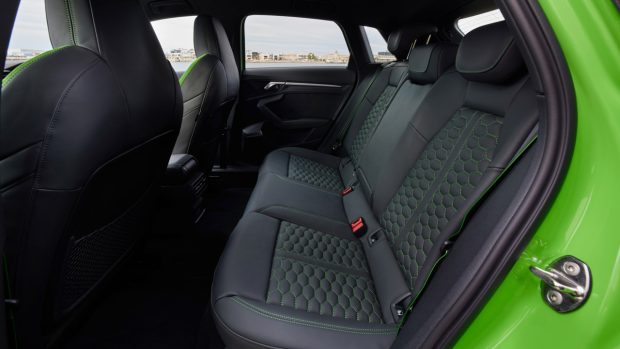
There are two body styles for the RS3 that will affect its practicality, but whether Sportback (286L) or sedan (321L) the boot is fairly generous. There is also a space saver-spare tire on board and a net is fitted as standard to keep luggage from flying around during the sort of inspired cornering the RS3 encourages.
What are the RS3’s running costs?
This may be the last outing for the RS3’s five-cylinder engine, but equally there may still be life left in it. According to Audi, a continuation of the popular engine will be all about demand. The brand says there’s no reason the five-cylinder couldn’t be made compliant with Euro 7 emissions standards set to come into effect in 2025.
Additionally, for the amount of grunt on offer the RS3 is relatively fuel efficient. The Sportback’s combined ADR consumption figure is a 8.3L/100km claim (the more aerodynamic sedan drops that to 8.2L/100km). On the launch, we saw 10L/100km on the on-board display, but we’ll have a test with more genuine real-world figures when we drive the RS3 back on home territory.
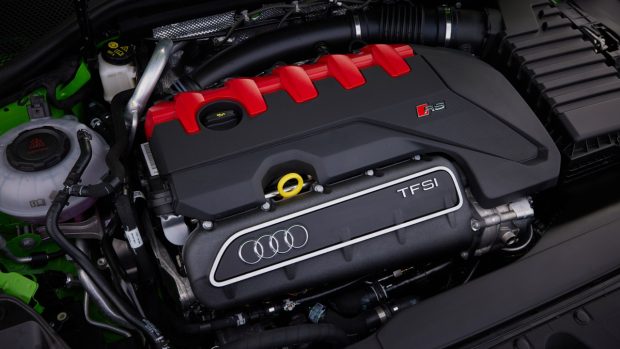
RS3 maintenance is due every 12 months/15,000km and Audi sells a five-year/75,000km service pack for $3850.
Like Mercedes-Benz – and almost every other premium manufacturer – Audi now offers a five-year, unlimited-kilometre warranty. However, if you want, Audi also offers the ability to extend the RS3’s warranty in two year increments up to a total of nine years.
The scheme is called Audi Advantage and, for the RS3, will cost $3,800 for two years and include the scheduled servicing during that period – a lot better than the three-year warranty offered by BMW in Australia.
The final verdict
Audi’s RS3 now has the deft and adjustable handling to back up its ever impressive straight-line speed. From a distance the new RS3 may not look hugely different to the car it replaces, but the combination of the RS department’s tweaks have culminated in an excellent hyper hatch.
And while the RS3’s interior may not feel a whole lot more special than the $20K-cheaper S3, listening to the unique five-cylinder warble is arguably worth the extra money alone.
The RS3 is also better value than the Mercedes-AMG A45, especially given the Audi doesn’t need any pricey option boxes ticked to make it feel whole.
Audi’s latest RS3 is a truly well-rounded and unique performance car that is accessible enough for a novice driver. It also now has enough nuance, adjustability and agility for an experienced pilot to enjoy both on the road and racetrack without sacrificing daily livability.
